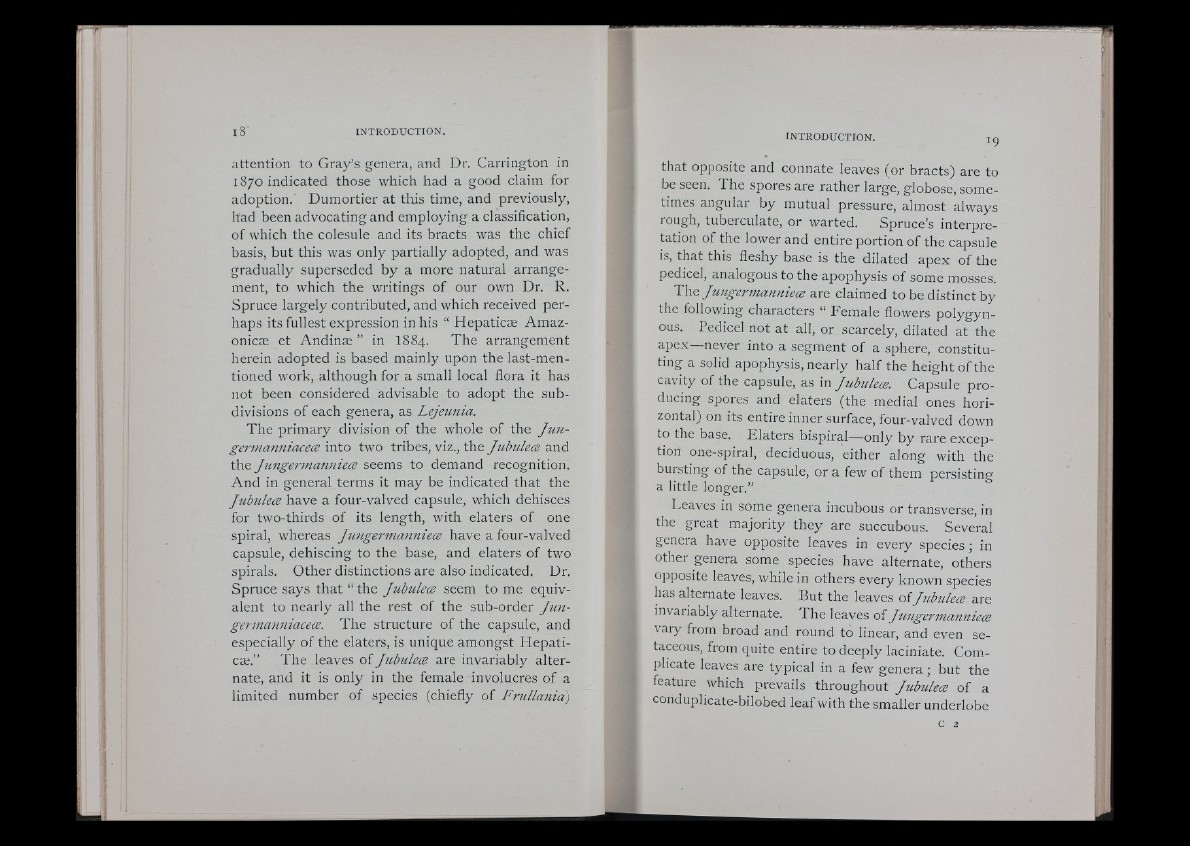
attention to Gray’s genera, and Dr. Carrington in
1870 indicated those which had a good claim for
adoption. Dumortier at this time, and previously,
had been advocating and employing a classification,
of which the colesule and its bracts was the chief
basis, but this was only partially adopted, and was
gradually superseded by a more natural arrangement,
to which the writings of our own Dr. R.
Spruce largely contributed, and which received perhaps
its fullest expression in his “ Hepaticæ Amaz-
onicæ et Andinæ ” in I884. The arrangement
herein adopted is based mainly upon the last-mentioned
work, although for a small local flora it has
not been considered advisable to adopt the subdivisions
of each genera, as Lejeunia.
The primary division of the whole of the Jun-
gennanniaceæ into two tribes, viz., the Jubuleæ and
the Jtingermannieæ seems to demand recognition.
And in general terms it may be indicated that the
Jubuleæ have a four-valved capsule, which dehisces
for two-thirds of its length, with elaters of one
spiral, whereas Jtingermanniece have a four-valved
capsule, dehiscing to the base, and elaters of two
spirals. Other distinctions are also indicated. Dr.
Spruce says that “ the Jubuleæ seem to me equivalent
to nearly all the rest of the sub-order Jun-
gêrmanniaceæ. The structure of the capsule, and
especially of the elaters, is unique amongst Hepati-
The leaves of Jubuleæ cæ. are invariably alternate,
and it is only in the female involucres of a
limited number of species (chiefly of Frullanid)
%
i
INTRODUCTION. 19
that opposite and connate leaves (or bracts) are to
be seen. The spores are rather large, globose, sometimes
angular by mutual pressure, almost always
rough, tubercLilate, or warted. Spruce’s interpretation
of the lower and entire portion of the capsule
is, that this fleshy base is the dilated apex of the
pedicel, analogous to the apophysis of some mosses.
Jungermannieæ are claimed to be distinct by
the following characters “ Female flowers polygyn-
OLis. Pedicel not at all, or scarcely, dilated at the
apex— never into a segment of a sphere, constituting
a solid apophysis, nearly half the height of the
cavity of the capsule, as in J ubuleæ. Capsule producing
spores and elaters (the medial ones horizontal)
on its entire inner surface, four-valved down
to the base. Elaters bispiral— only by rare exception
one-spiral, deciduous, either along with the
bill sting of the capsule, or a few of them persisting
a little longer.”
Leaves in some genera incubous or transverse, in
the great majority they are succubous. Several
geneia have opposite leaves in every species ; in
other genera some species have alternate, others
opposite leaves, while in others every known species
has alternate leaves. But the leaves of Jubuleæ are
invariably alternate. The leaves of Jungermannieæ
vary fiom broad and round to linear, and even setaceous,
from quite entire to deeply laciniate. Complicate
leaves are typical in a few genera ; but the
feature which prevails throughout Jubuleæ of a
conduplicate-bilobed leaf with the smaller underlobc
c 2
D